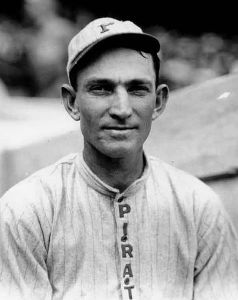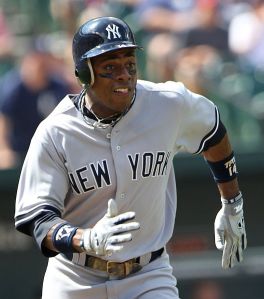Query a hundred fans on baseball’s most exciting moment and you’ll quickly get a consensus: The home run, round-tripper, four-bagger, dinger, space-shot, big-blast, the tater. Versus visitors, the strike-out draws cheers but it’s the homer that flies fat in nearly everyone’s wheelhouse.
The roundtripper, even the exhibition variety, is why Major League Baseball’s July festival, traditionally termed the All-Star break, has, in recent years, supplanted the fall classic as the season‘s highpoint for muscle-lovin’ teens and the sabrmetrically-minded sportician.
But in fact, it’s the three-bagger which is baseball’s most exciting event, that is assuming that no owner (Nick Mileti) ever again holds a “Ten-Cent Beer Night (Municipal Stadium 6.4.74).”
— — —
It’s Baltimore-born Babe Ruth (1895-48), the man who sportswriter Jimmy Cannon so aptly pegged “a parade all by himself,” that is frequently cited for making the long-ball the game’s most popular moment (1914-35 / 714 HR).
Once he’d completed his conversion from moundsman, and a good one (94-46 / 2.28 BOS), to a near everyday outfielder in his final Boston season when he clubbed 29 round-trippers (1914-19), the HR barrage began. In his first foray in pinstripes, the Bambino hit a then whopping 54 tators in just 142 games.
Though in a league all his own, Ruth did have his competitors.
Another American Leaguer, oft overlooked Ken Williams (Browns – Orioles), did his part to boost the big blast by socking close to 200 homers from 1920 to 29 on a career .319 batting average. Power AND contact were clearly in vogue.
Kings of Clout in the senior loop included lanky Fred “Cy” Williams (Cubs / Phillies) who became the first major leaguer to retire with 250+ dingers (1930: 251hr – .292), and Rogers “Raja” Hornsby who won two homer titles in the 20s and amassed 301 four-baggers by the time he’d hung up his spikes in 1938.
That the game would turn into a slugfest might’ve been a foreseeable consequence when, in the 1910-11 off-season, Cufflinks decided to ditch the dead-ball in favor of a lively, jackrabbit variety to boost offense by adding cork to what had been, since late 1800s, a simple rubber & twine core composition.
As part of that mission to increase run output, the spitter and other manner of doctoring would be outlawed (20), while practice of using a ball until the hide came off was banished in favor of regular replacement, which also allowed fans to keep the prize when gotten, a practice begun by AL founder Ban Johnson.
By the mid-20s the home run had firmly established itself as the new staple in baseball’s diet, peaking in 1961 when Highlanders Maris & Mantle, challenged Ruth’s 1927 mark of 60. Roger bested it by one, Mantle finished at 54.
Then things settled down .. for a time.
Willie Mays (1965) and the Big Red Machine’s big blast, George Foster (1977), both slammed fifty, while Hammerin’ Hank Aaron surpassed the Bambino’s 714 career mark in the summer of 1974 (755).
But a plague was soon to permeate the game, Stateside and abroad.
Not game-fixing this time (19) (That’ll return, now that the ivory-towered Robes have given a green-light to the co-mingle of sports and betting (Murphy v. NCAA)), but a sickness where players, though seeking to improve their play for better pay, began to do so in an unhealthy, unfair and corrupt manner.
The plague is drugs. Not the recreational variety that surged in the 70s, but one referred to today by its acronym, PEDs, performance enhancing drugs.
The permeation was not stealth.
It arrived in the early 1980s, mostly, not always, in younger players.
Some, like the brash Bash Brothers were atypically muscle-bound and began to collect Pennants fast (88-91). Others, already showing major capability (Bonds Clemens Palmero) chose badly in dismissing the morality (cheat) and played catch-up to fatten stats, paychecks and heads, literally, only to be given a pass by a greed-driven media (repeat PED suspendee Alex Rodriquez employed by Disney-ESPN in 2017), indifferent Commissioners and a scared player union.
The evil element ushered in cheating, unaccountability, dishonesty and greed, not just in players, managers and owners who all benefited from the ill-gotten surge in power, but the fans who looked the other way, and still do, in misguided hero-worship and collectibility craze.
Exactly who, how many and specific season it was first introduced won’t ever be known (some users have been exposed, a few have, kind of, sort of, came clean), but we DO know one of its biggest proponents in Canseco was the first to go public in exposing the epidemic in his 2005 best-seller, Juiced (ReganBooks). Jose’s had his hand on “the chicken-switch” not long after publication (back-tracking, etc.), but what’s done is done.
Since the plague permeated the game on a swiss-cheese testing policy (Cano 2018), pro baseball has become a fraud, worsened on a Commissioner Rob Manfred who skews the balance in allowing batters body armor and worse, enables racism (Astros’ Yuli Gurriel WS2017): No truth means no trust which means MLB is no longer America’s national pastime. That honor goes, not to the NFL, NBA or NHL, but to gambling.
Even as every team championship and player award now takes on a taint, there ARE individual efforts in the game that escape the stench of corruption and greed. And one of those is the triple. That’s right, the three-bagger.
Typically, it’s the most thrilling single-act in the game of baseball.
In the days before rocket-shots became commonplace, the national pastime’s focus was on the manufacture of runs. That meant keeping the other team off base with mindful moundsmen and sure-handed fielding, then getting your guys on those bags in any way possible: Singles, doubles, walks, bunt-hits or hit-by-pitch-free-on-boards when batting helmets were non-existent.
The triple, falling short of that rare home run in earlier, fence-less battlegrounds, was the managers’ dream. If gotten one early in the order, a mere single, sacrifice fly or wild-pitch would result in a score which meant plenty when pitchers usually went the distance and 2-0 outcomes were common.
In the 1910s, cork was added to the ball’s rubber core and ushered out the dead-ball era to begin the golden age of homers, triples and .400 batting averages.
It was the decade when John McGraw’s rough & tumble New York Giants were winning games like nobody’s business, though, on three pennants couldn’t close the deal (0-3) against the Philadelphia Athletics (1910-11, 13) or Boston Red Sox (1912, 15-16, 18), both teams who were winning World Series like big business. Big until the 1920s Yankees started ‘murdering’ and ‘bombing.’
The year 1912 marks the apex of single-season, individual triple total when Pittsburgh Pirates outfielder John Owen “Chief” Wilson (6’2”) set the single-season mark that still stands to this day with 36 tres (114). It would be Chief’s most outstanding personal career stat in a fine overall season where he batted an even .300 (2nd of back-to-backs) on 94 ribbies and double-digit taters at eleven (11), pretty nifty in the soon to cease Dead-Ball era.
In the team sense, Chief Wilson is most memorable as a capable sophomore starter on the Honus Wagner led Pirates championship club of 1909 when the Buccaneers bested the Ty Cobb – Sam Crawford Detroit Tigers in seven games in one of the era’s top World Series tussles.
Unrelated but curious that only two seasons later in 1914, MLB instituted a rule that gives the batter-baserunner 3-bases (triple) if a fielder throws their hat or glove at the ball in attempt to stop or slow its progress (1001 Fascinating Baseball Facts, Nemec & Palmer, 1994, P/I-Ltd.).
The triple was on the brain, collectively speaking.
More recently, only three other players since the Royals’ George Brett (79), Phillies’ Jimmy Rollins (07) and Twins Christian Guzman all reached the 20T mark, have surpassed it: Royals’ Willie Wilson (85) and the Mets’ Lance Johnson (96) bagging 21 each and the Tigers’ Curtis Granderson running-out 23 in 2007.
Taking a gander at the career totals, it becomes evident very quickly that left-handed batters have a clear advantage to tacking on that extra third bag.
South-saw, Sam Crawford leads the way with 309, followed by long-time teammate, Ty Cobb at 295 and super shortstop Honus Wagner, one of only three righties (one a switch-hitter Roger Connor) in the top-ten, comes in third at 252.
And often described as spindly-legged, Babe Ruth himself, he who clouted home runs like he downed hot dogs, topped the double-digit triple mark four (4) times, tallying as many as sixteen (16) in his monumental 1921 season when he hit 59 taters, scored 177 runs, slugged .846, batted-in 168 and averaged .378. Phew!
As of this posting, only one man, Ketel Marte of the Diamondbacks, has even reached as many as ten (10) triples in either loop in the 2018 MLB campaign.
Why has the triple become a such rare commodity post-World War 2?
Unlike their sporting predecesors, today’s ball-cap wearer is unwilling to take the chance in stretching a double into a triple when shorter fences, the liveliest ball in history, batter body-armor (face-masks) that skews the balance and a still present PED boost, all make the home run a nearly every-inning possibility.
 StevenKeys
StevenKeys
Can-o-Corn
Photo Credit: Owen-Wilson, American-Tobacco-Company, LoC, wc.cca, 1909; Owen-Wilson, 1912, The-Sporting-News, wc; Sam-Crawford, The-Sporting-News, wc; Curtis-Granderson, K.Allison, 2011, Baltimore, wc; Canned-corn
Posted: 9.6.18 @ 12:00aE; Copyright © 2018



